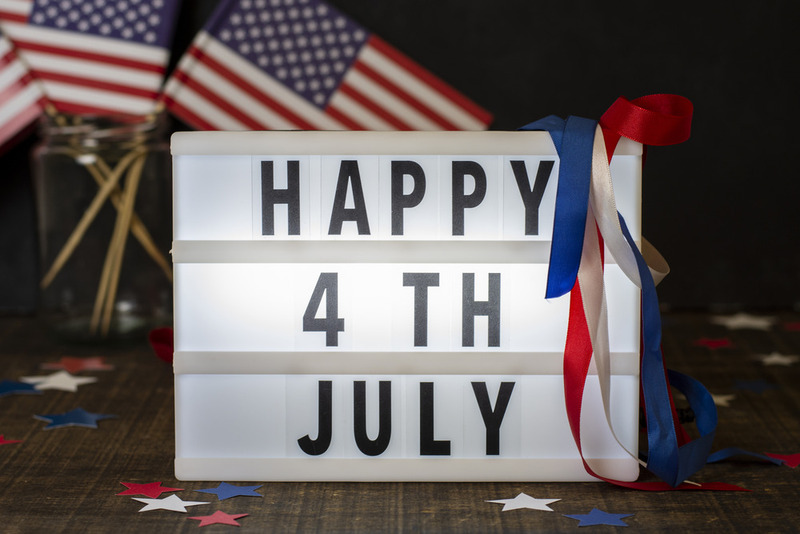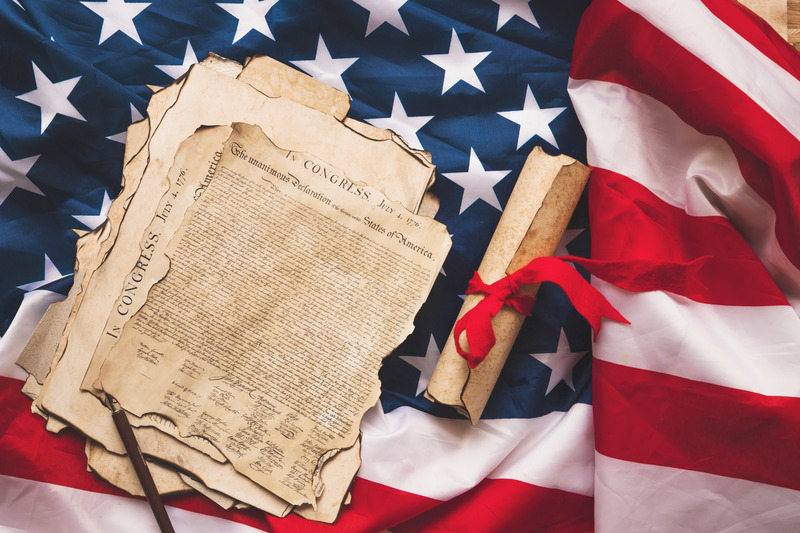The Story Behind July 4th: The History of America’s Independence Day

In the heart of summer, Americans across the nation come together for a day that echoes with history and resonates with pride: Independence Day. However, looking deeper than the fireworks and barbecues, we will find a dramatic story of defiance and determination of the American people – the story of the American Revolution.
In this article, we’ll journey through the Independence Day history, exploring how July 4th became a federal holiday and trace its evolution from a declaration of liberal principles to a worldwide symbol of liberty. And as we go, we’ll also find out how this day continues to resonate with people not just in America, but all over the world.
Early Colonial Life
To fully understand the history of Independence Day, we first need to look at the early colonial life period – where the roots of American independence took hold. The first permanent English settlement was established in Jamestown, Virginia, in 1607. Life for these early settlers was made hard by unpredictable weather, disease, and complex relationships with Indigenous peoples. Despite these challenges, the colonies expanded, and by the mid-18th century, thirteen colonies dotted the Atlantic coast.
Society in the colonies was hierarchical, with wealthy landowners and merchants at the top, and small farmers, artisans, and laborers forming the majority. Politically, each colony had its own government, complete with a governor, council, and elected assembly. These assemblies, managing local affairs and taxes, overtime, helped nurture a spirit of self-governance and laid the groundwork for future autonomy.
Religion also played a significant role in the early Independence Day USA history, with settlers seeking religious freedom establishing diverse communities like the Puritans in Massachusetts and Quakers in Pennsylvania. These communities valued moral integrity, communal responsibility, and the right to dissent – principles that would later drive the revolutionary movement.
The Prelude to Independence
Following the French and Indian War (1754-1763), Britain faced massive debt and looked to the American colonies as a source of revenue. That’s why the British government began implementing a series of taxes and laws that angered the colonists, who had grown accustomed to a degree of autonomy. The Stamp Act of 1765, which imposed a direct tax on all printed materials, was particularly inflammatory – colonists argued that it was unjust to be taxed without representation in the British Parliament, coining the famous phrase, “No taxation without representation.”
The Townshend Acts of 1767, which placed taxes on common goods like tea, paper, and glass, further inflamed tensions. The colonists responded with boycotts and increased smuggling to avoid the taxes. The situation escalated with the Boston Massacre in 1770, where British soldiers killed five colonists during a confrontation. This event was widely publicized and used as propaganda to fuel anti-British sentiment.
In 1773, the Tea Act aimed to bail out the struggling British East India Company by granting it a monopoly on tea sales in the colonies. This led to the Boston Tea Party, where colonists, disguised as Mohawk Indians, dumped an entire shipment of tea into Boston Harbor in protest. The British government’s harsh response came in the form of the Coercive Acts (also known as the Intolerable Acts), which included closing Boston Harbor and revoking Massachusetts’ charter.
These punitive measures only strengthened colonial resolve. The First Continental Congress met in 1774, bringing together delegates from twelve of the thirteen colonies to discuss a unified response to British aggression. They agreed to boycott British goods and began forming militias in preparation for possible conflict.
The Continental Congress and the Declaration
 Convening first in 1774, the Congress served as the central governing body for the colonies, uniting them in their resistance against British rule and ultimately leading them to declare independence. On June 7, 1776, Richard Henry Lee introduced a resolution declaring that the colonies “are, and of right ought to be, free and independent States.” This set the stage for the drafting of the Declaration of Independence.A committee was appointed to draft this historic document, consisting of Thomas Jefferson, John Adams, Benjamin Franklin, Roger Sherman, and Robert R. Livingston.
Convening first in 1774, the Congress served as the central governing body for the colonies, uniting them in their resistance against British rule and ultimately leading them to declare independence. On June 7, 1776, Richard Henry Lee introduced a resolution declaring that the colonies “are, and of right ought to be, free and independent States.” This set the stage for the drafting of the Declaration of Independence.A committee was appointed to draft this historic document, consisting of Thomas Jefferson, John Adams, Benjamin Franklin, Roger Sherman, and Robert R. Livingston.
And soon came a point where the American Independence Day history culminated – adopted on July 4, 1776, the Declaration was a profound statement of human rights and democratic ideals. Its preamble begins with the iconic words: “We hold these truths to be self-evident, that all men are created equal, that they are endowed by their Creator with certain unalienable Rights, that among these are Life, Liberty and the pursuit of Happiness.”
The Principles and Ideals Outlined in the Declaration
The Declaration outlines several key principles and ideals that have become cornerstones of American democracy:
- Equality and Natural Rights: The assertion that “all men are created equal” was a radical departure from the hierarchical structures that dominated European societies. It introduced the concept that every individual is entitled to equal rights by virtue of their humanity.
- Government by Consent: The Declaration emphasizes that governments derive “their just powers from the consent of the governed.” This principle of popular sovereignty means that legitimate political authority rests on the will of the people, not on hereditary rule or divine right.
- Right to Revolution: The Declaration asserts the right of the people to alter or abolish any form of government that becomes destructive to their rights and to institute a new government that better secures their safety and happiness. This was a direct justification for the colonies’ decision to break away from British rule.
- List of Grievances: Jefferson’s draft included a detailed list of grievances against King George III, accusing him of violating the colonists’ rights and imposing unjust laws.
- A Call to Action: The Declaration concludes with a resolute commitment to independence, stating that the colonies “are, and of right ought to be Free and Independent States.” It affirms their full power to wage war, conclude peace, contract alliances, establish commerce, and perform all other acts and things which independent states may of right do.
Key Figures in the Independence Movement
Without a doubt, there were many prominent people during The American Revolution and the fight for independence. Amongst those, perhaps, the most notable are:
- George Washington: Known as the Father of His Country, George Washington was the commander-in-chief of the Continental Army. Washington’s ability to maintain the morale and cohesion of his troops, especially during the harsh winter at Valley Forge, are what made him a legendary military leader
- Thomas Jefferson: The principal author of the Declaration of Independence, Jefferson’s eloquence and philosophical insight helped to articulate the colonies’ reasons for seeking independence. His words in the Declaration laid the ideological groundwork for American democracy, emphasizing natural rights, equality, and government by consent
- John Adams: Adams played a crucial role in persuading other delegates to support the Declaration of Independence and was a member of the committee tasked with drafting the document. Adams’ diplomatic efforts were also instrumental in securing French support for the American cause.
- Benjamin Franklin: Benjamin Franklin was another key negotiator in securing French assistance during the Revolution. His persuasive skills helped to form a crucial alliance with France, which provided essential military and financial support to the American cause.
- Samuel Adams: A passionate advocate for liberty and a master of political propaganda, Samuel Adams helped to ignite revolutionary fervor in the colonies. He was a key organizer of the Sons of Liberty and played a central role in events like the Boston Tea Party.
And did you know you may share a bloodline with one of these fine gentlemen? Time to embark on your first genealogical adventure and find out – and with Treemily, it’s very simple!
Once you’re done with your research, you can export your family tree to a stunningly looking PDF or even have it printed on paper of the size of your choosing.
Major Battles of the Revolutionary War
The American Revolutionary War, fought between 1775 and 1783, had many great battles that showcased the resilience and strategic ingenuity of the Continental Army. ultimately leading to the establishment of the United States:
- The Battles of Lexington and Concord (April 19, 1775): Often referred to as “the shot heard ’round the world,” the Battles of Lexington and Concord were the opening act to the Revolutionary War. As the British forces aimed to take control of the vital military supplies, the militia voraciously fought against it. However, the scale of battles wasn’t as big as many people believe – the resulting skirmishes only brought upon 124 confirmed deaths from both sides. They ended in a surprising victory for the colonists and marked the beginning of open armed conflict between Britain and the American colonies.
- The Siege of Boston (April 1775 – March 1776): This prolonged siege saw American forces encircling the city of Boston, where British troops were stationed. Under the leadership of General George Washington, the Continental Army fortified positions around the city. The siege ended when the Americans, using artillery captured from Fort Ticonderoga, forced the British to evacuate Boston in March 1776, making it a significant early victory for the revolutionaries.
- The Battle of Trenton (December 26, 1776): Following a series of defeats and the harrowing winter at Valley Forge, Washington’s daring crossing of the Delaware River on Christmas night led to a surprise attack on the Hessian garrison in Trenton, New Jersey. The victory at Trenton was a much-needed morale booster for the Continental Army and demonstrated Washington’s leadership and strategic acumen.
- The Battle of Saratoga (September 19 and October 7, 1777): Often cited as the turning point of the Revolutionary War, the Battles of Saratoga culminated in the surrender of British General John Burgoyne’s army. The American victory, achieved through the efforts of Generals Horatio Gates and Benedict Arnold, persuaded France to enter the war as an ally to the United States.
- The Battle of Cowpens (January 17, 1781): This was a turning point in the southern campaign – under the command of General Daniel Morgan, the American forces executed a brilliant double envelopment tactic, leading to a decisive victory over the British forces in South Carolina.
- The Battle of Yorktown (September 28 – October 19, 1781): The Siege of Yorktown was the decisive victory that effectively ended the Revolutionary War. American and French forces, commanded by General Washington and General Rochambeau, trapped British General Cornwallis’s army at Yorktown, Virginia. The British surrendered on October 19, 1781, which was ultimately the end of major hostilities.
Early Celebrations of Independence Day
The first organized celebrations took place in Philadelphia, where the Continental Congress had approved the Declaration of Independence. On July 4, 1777, Philadelphia held a grand celebration including bells ringing, bonfires, and fireworks. The city was illuminated as citizens rejoiced in the newly declared independence from British rule, which set a precedent for future celebrations across the young nation.
In the following years, communities throughout the thirteen colonies began to adopt their own traditions to commemorate the Fourth of July. These included public readings of the Declaration, parades featuring military displays, patriotic music, and ceremonial cannon fire. By the early 19th century, Independence Day celebrations had spread beyond major cities like Philadelphia and Boston to towns and villages across the nation.
Modern Celebrations of Independence Day
Perhaps the most iconic feature of modern Independence Day celebrations are the fireworks displays. From small towns to major cities, Americans gather at parks, beaches, and stadiums to witness spectacular pyrotechnic shows that light up the night sky with bursts of color. Many festivals are also held across the country – decorated floats, marching bands, and other displays of patriotic pride all fill the streets.
On top of that, Independence Day is also synonymous with family gatherings and backyard barbecues. Grilled favorites like hot dogs and hamburgers, along with traditional American fare such as apple pie are the must-haves on this occasion, as families and friends come together to share meals, play games, and enjoy each other’s company.
And since Independence Day coincides with summer vacation, the conditions are there to make it an ideal time for outdoor activities and sports tournaments. Baseball games, in particular, hold a special place in Fourth of July celebrations, with many Major League Baseball teams playing home games and incorporating patriotic themes into their events.
The Global Influence of American Independence
The revolution served as a launchpad for establishing a republic based on representative democracy, in which elected officials serve the interests of the people. This quickly became a role model for other nations seeking to replace monarchies and authoritarian regimes. For example, the success of the American Revolution influenced subsequent revolutions, such as the French Revolution (1789) and Latin American independence movements in the early 19th century.
Likewise, the principles articulated in the Declaration of Independence contributed to the global discourse on human rights. Individual liberty, equality before the law, and the right to self-governance became fundamental concepts all over the world.
Hard to ignore is also the soft power that this holiday has granted – American music, films, literature, and art have captivated audiences worldwide and spread the American values and ideals like independence, creativity, and individualism. This way, Independence Day celebrations, including the iconic fireworks and parades, have become cultural symbols everywhere on the planet.
Conclusion
It’s clear that July 4th is far more than a holiday, as the day itself marks a pivotal chapter in human history. Beginning with the early struggles of colonial life and escalating through defiance against British taxation, the US Independence Day history culminates in the Declaration of Independence, a document that boldly asserts principles of equality, natural rights, and government by consent.
In the present, Independence Day still inspires democratic movements worldwide, and its cultural impact is passed from generation to generation through American art, music, and literature, spreading ideals of independence, creativity, and individualism.
And what you can also pass from one generation to another is your own family tree! Create a free Treemily account, choose your preferred tree layout, and put in the information about your family. Once you’re done, you can export it to a stunningly looking PDF or have it printed on paper of the size of your choosing. Let’s go!
FAQs
Why Is July 4th Celebrated in the United States?
July 4th is celebrated in the United States as Independence Day because it is associated with the adoption of the Declaration of Independence by the Continental Congress in 1776. This historic document declared the thirteen American colonies independent from British rule, establishing the United States of America as a sovereign nation.
What Happened on July 4th, 1776?
On July 4, 1776, the Continental Congress formally adopted the Declaration of Independence, which had been drafted primarily by Thomas Jefferson. This document asserted the colonies’ independence from Great Britain and articulated the principles of individual rights, self-governance, and liberty that continue to shape American identity today.
Who Were the Key Figures in the American Independence Movement?
Key figures in the American Independence movement included Thomas Jefferson, who drafted the Declaration of Independence; John Adams, who advocated for independence and later became the second U.S. President; Benjamin Franklin, a diplomat and statesman crucial in securing French support; George Washington, who led the Continental Army; and many others.
How Has the Celebration of Independence Day Evolved Over the Years?
Initially involving public readings of the Declaration, bonfires, and military displays, Independence Day celebrations have evolved into elaborate festivities with fireworks, parades, concerts, and family gatherings.
What Are Some Common Traditions and Symbols Associated With July 4th?
These include fireworks displays, which originated in 1777 in Philadelphia; parades featuring patriotic themes and floats; the American flag; barbecues and picnics with family and friends; and patriotic songs such as “The Star-Spangled Banner” and “America the Beautiful,” which are sung at public events and gatherings nationwide.





